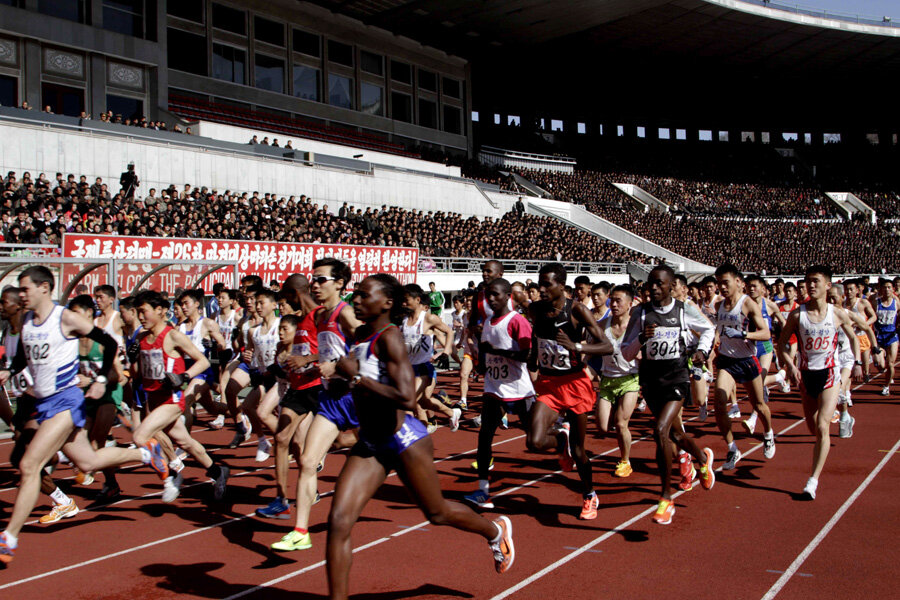North Korea opens up to host marathon
Loading...
| Pyongyang, North Korea
The streets of North Korea's showcase capital were filled with runners from all over the world on Sunday for the annual Pyongyang marathon, which was open to foreign amateurs this year for the first time.
Tens of thousands of North Koreans lined the streets to applaud, cheer and sometimes high-five the runners, who were followed by a truck blaring patriotic music. They stood and roared as North Korea's Pak Chol, who completed the men's event in 2 hours, 12 minutes and 26 seconds, crossed the finish line. Compatriots Kim Hye Gyong and her twin sister, Kim Hye Song, finished first and second in the women's race. The winning women's time was 2:27:04.
Known officially as the Mangyongdae Prize International Marathon, the race is sanctioned as a bronze-label event by the International Association of Athletics Federations and has been held annually for 27 years. Organizers said they decided to allow foreign recreational runners because they wanted to hold a grander race as part of the series of sporting competitions, arts festivals and cultural events marking the birthday of the nation's founder, Kim Il Sung, on April 15.
Much of North Korea remains off-limits to foreigners, but Pyongyang, with its broad avenues, plazas and ubiquitous monuments, is more accessible than other places in the secretive and isolated country.
The opening of the race to recreational runners is in keeping with the North's ongoing effort to earn cash revenue by boosting tourism, usually with group tours to major arts performances or attractions the North wants to show off. Tourism agencies that specialize in North Korea said they were surprised by the large number of entries they received, but noted most were from tourists who primarily wanted to take advantage of the opportunity to see Pyongyang close up, rather than compete in the race itself.
Officials said runners from 27 countries took part this year, including 225 amateurs. Though the race has long featured elite athletes from around the world, organizers decided to make it easier for fun-runners to join in by requiring only that the course be completed in four hours — so the roads could be reopened — and by also holding a half marathon and a 10-kilometer run.
"I really wanted to do this race because of the location," said 10-kilometer runner Jen Skym, a 32-year-old Briton living in Hong Kong, who is also four months pregnant. "The scenery was fantastic, and there were so many people watching. It was good motivation to get back into running. I really enjoyed it."
Runners on the generally flat, full-marathon course did four loops around the center of the city of 2.5 million, starting at Kim Il Sung Stadium, moving past the Arch of Triumph, the Friendship Tower and the Kim Il Sung University area. They then crossed a bridge to the east side of the city and wound their way along the river bank to the stadium. The capacity crowd of 42,000 spectators back in the stadium were treated to soccer games and martial arts exhibitions while they waited for the runners to return.
Earlier this year, North Korea's government announced a plan to create special trade and tourism zones across the country and unveiled its first luxury ski resort, aimed largely at luring ski enthusiasts from abroad. Under the watch of young leader Kim Jong Un, the North has also been giving sports in general a higher profile. Simple recreational sports facilities, such as outdoor basketball courts and roller skating rinks, have been popping up lately in Pyongyang and some other cities.
"I go to international races every year, but this one just strikes me as the most unique," said Jacob Young, of Nova Scotia, Canada. "It's very novel. Usually I would imagine it's the tourists here looking out at the local people. Here, it's them looking at us. We are the show."
To keep the show from getting too colorful, however, the foreign runners were instructed not to carry U.S. or Japanese flags, or wear clothing with large writing or that was deemed inappropriately attention-getting or political — though one wore blue jeans for the 10-kilometer event. Runners said they were also not allowed to carry cameras during the race, though they snapped away afterward inside the stadium.
"Basically, we just had to wear regular running clothes," said Will Erskine, of Melbourne, Australia. "Some people might have wanted to shoot pictures the whole time. But I don't think it was all that unusual. It was a good experience."







